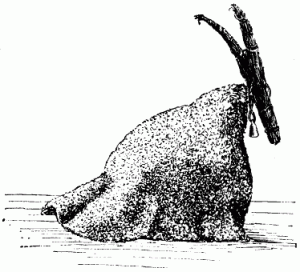While discussing the Krampus with some family members, my mother mentioned that, during her pregnancy with me, a Swedish aunt of hers had told her of a deer or goatlike creature called the “Julebukk” which helped pull Santa’s sleigh.
From what I’ve been able to tell, the tradition started with the legend of the Norse god of thunder, Thor! Thor was said to ride across the sky in a chariot drawn by two goats, Tanngrisnir and Tanngnjóstr (roughly translated as “Toothgnasher” and “Toothgrinder”), the sound of which created the sounds of thunder rumbling. According to the “Prose Edda,” Thor was known to kill the goats in order to have food, which he would share with others. After the meal finished, Thor would use his powers to revive them as if nothing happened. This led to a now-defunct Swedish winter tradition of having someone dress up as a goat, pretend to get sacrificed and is later “revived.” But as Christianity spread throughout Europe, all references to Thor were stripped away and the creature was transformed into a Yule Goat or “Julebukk” (roughly translated as “Christmas buck”).
But the Julebukk was no mere goat. Some traditions said it was half human, while in others, it is a nasty beast that frightens children. But over time, this was softened into a friendly, magic goat that brings presents and tells funny poems. Naturally, this was merely a family member or friend dressed in a costume. Although Father Christmas (aka Santa Claus) eventually took over such duties, the goat became his assistant in some cultures. In some places, the Yule goat figure was actually turned into a human Santa Claus figure! That said, the Julebukk’s nasty past wasn’t completely removed from the character, as the newer depiction also has a mischievous streak. Also, straw Yule Goats became popular Christmas ornaments among Scandinavian cultures. In fact, the downstairs mantle of my childhood home had a straw Julebukk decorating it, but I had never knew of its significance until recently.
The Julebukk also led to the tradition of Julebukking (aka “Christmas fooling”), which involves going door to door for treats in disguise between Christmas and New Year’s Day. Originally, carrying a goat’s head was part of the tradition, but that was phased out in favor of just wearing goatish costumes. Julebukking traditions vary, but all share the basic idea of going from house to house in disguise to get treats. Does anyone else think that sounds kind of familiar? As for the various traditions, some hold that Julebukkers disguise their voices and body language and don’t go to the next house until their identity is uncovered while another tradition requires the singing of Christmas songs. Sometimes a person from the visited home will be required to join the Julebukkers on their trip to the next home! It’s not just practiced in Europe, either. According to this, there are still some communities in the US that still continue this ancient tradition. If any of our readers do this, we hope that you’ll post your favorite Julebukking memories and pictures here.


1 pings
[…] addition to the Krampus, other Christmas beasts have been discussed here before but somehow we missed discussing the Yule Lads (along with […]